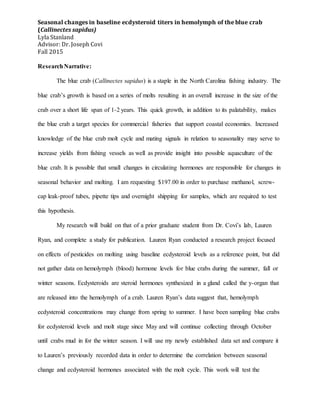
Stanland CSURF Final
- 1. Seasonal changes in baseline ecdysteroid titers in hemolymph of the blue crab (Callinectes sapidus) Lyla Stanland Advisor: Dr. Joseph Covi Fall 2015 ResearchNarrative: The blue crab (Callinectes sapidus) is a staple in the North Carolina fishing industry. The blue crab’s growth is based on a series of molts resulting in an overall increase in the size of the crab over a short life span of 1-2 years. This quick growth, in addition to its palatability, makes the blue crab a target species for commercial fisheries that support coastal economies. Increased knowledge of the blue crab molt cycle and mating signals in relation to seasonality may serve to increase yields from fishing vessels as well as provide insight into possible aquaculture of the blue crab. It is possible that small changes in circulating hormones are responsible for changes in seasonal behavior and molting. I am requesting $197.00 in order to purchase methanol, screw- cap leak-proof tubes, pipette tips and overnight shipping for samples, which are required to test this hypothesis. My research will build on that of a prior graduate student from Dr. Covi’s lab, Lauren Ryan, and complete a study for publication. Lauren Ryan conducted a research project focused on effects of pesticides on molting using baseline ecdysteroid levels as a reference point, but did not gather data on hemolymph (blood) hormone levels for blue crabs during the summer, fall or winter seasons. Ecdysteroids are steroid hormones synthesized in a gland called the y-organ that are released into the hemolymph of a crab. Lauren Ryan’s data suggest that, hemolymph ecdysteroid concentrations may change from spring to summer. I have been sampling blue crabs for ecdysteroid levels and molt stage since May and will continue collecting through October until crabs mud in for the winter season. I will use my newly established data set and compare it to Lauren’s previously recorded data in order to determine the correlation between seasonal change and ecdysteroid hormones associated with the molt cycle. This work will test the
- 2. Seasonal changes in baseline ecdysteroid titers in hemolymph of the blue crab (Callinectes sapidus) Lyla Stanland Advisor: Dr. Joseph Covi Fall 2015 hypothesis that ecdysteroid levels change in subtle ways as the animals progress from one season to the next. I predict that crabs collected in the spring and fall seasons will be closer to stage E (ecdysis), and have higher baseline ecdysteroid concentrations, similar to those cited by Lauren. This data set is the central focus of my Honors Project and upon completion of data collection; I will write an undergraduate thesis detailing my completed work. The experience I gain from designing and completing a research project with a written thesis will enhance my PhD applications and provide me with the confidence and practice necessary for a successful career in the research field. This data can also be used to improve the fishing industry. Using seasonal data on molt cycles, blue crab fisheries can modify collection schedules to obtain the best possible yield. My project will serve as a tool for local economies and will lead to an increase in crabs caught and subsequently an increase in profit for local fisheries.
- 3. Seasonal changes in baseline ecdysteroid titers in hemolymph of the blue crab (Callinectes sapidus) Lyla Stanland Advisor: Dr. Joseph Covi Fall 2015 Supplies Needed: Methanol $54.00 Screw-cap leak-proof tubes $55.00 Overnight shipping of samples to Bodega Bay $40.00 Pipette tips $48.00 Total Requested: $197.00 Budget Justification: I am requesting funds for materials needed for sample preparation as well as shipping costs to send samples for ecdysteroid quantification. In order to quantify ecdysteroid concentrations in blue crab hemolymph, I will collect hemolymph from crabs in the field using a technique developed by Dr. Covi, and send samples to a laboratory that will provide us with measurements of ecdysteroid concentrations. For each crab used in the study, I fill two screw-cap tubes with 300μl of methanol via pipette. In addition to the drawing of hemolymph, I also collect mouth parts to determine molt stage. I pipette a small volume of Pantin’s Saline Solution into tubes to store the mouth parts, until I return to the lab. I pull two samples of hemolymph from each crab caught, and add 100μl to the tubes containing methanol. Using dissection scissors and forceps, I cut a small section of the mouth part and place it into a tube containing Pantin’s Saline. I store the hemolymph samples at -20 degrees C, and look at mouthparts under a dissecting microscope to determine what stage of the molt cycle the animal is in. Once I am finished with sample collection, I will ship hemolymph samples to the Bodega Bay Marine Laboratory in Bodega Bay, California. Dr. Ernie Chang is a collaborator of Dr. Covi who has perfected an assay to determine the concentration of ecdysteroid hormones in crab hemolymph. Dr. Chang will run the assay free of charge; however I will need to purchase overnight shipping for the samples.